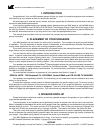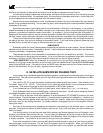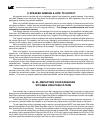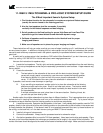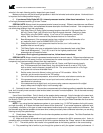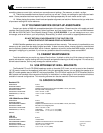
Bookshelf-75/Center-75/LCR-75/LCR-55
page 6
LEFT SPEAKER RIGHT SPEAKER
Line X - Y should equal
line A - B. (line A - B appears
longer in this diagram due
to an optical illusion).
B
On Figure 2, the length of line A - B should be about the same as the length of line X - Y. (They may not seem
to be the same in this diagram due to an optical illusion).
Try to follow the formula as close as you can. You can fine tune the placement by listening to a source with an
image (such as a vocalist) centered between the speakers. When listening in stereo (no Center Channel speaker),
move the speakers closer together or farther apart in small increments until you hear the sharpest and most cohesive
image, especially in the phantom center. You may also want to angle (or "toe-in") the speakers slightly. This often
improves the sharpness of the stereo image, reduces room colorations, and provides a wider seating area. The angled
front baffles of your Speakers also provide this benefit.
7. HOME THEATRE USAGE
LEVEL-MATCHING
The factor most critical to achieving excellent Home Theatre performance is level-matching the three front and
two surround channels. This is even more important than timbre-matching. We strongly recommend that you purchase
a Radio Shack Sound Level Meter (available for less than about $40, and get the analog meter, not the digital) and
use it to measure the output of the speakers when playing the test tones generated by your processor or receiver.
Set the meter to the "C" weighting scale, and using your amplifier or receiver's internal noise calibration test, set
the levels so that all channels measure the same level. WHENEVER POSSIBLE, DO NOT CALIBRATE LEVELS BY
EAR! Using a meter is an inexpensive way to be certain that your system is calibrated properly.
TIMBRE-MATCHING
One of the most important factors in achieving excellent Home Theatre performance is timbre-matching. On film
soundtracks, specific sounds are often moved from left to right or from front to back in the room. When the speakers
reproducing these sounds have dissimilar characteristics, there will be an audible discontinuity when the sound shifts
from one speaker to another.
Timbre-matched speakers have very similar tonal characteristics and sound, which come from three critical
elements: similar or identical drivers; similar or identical crossovers; and similar or identical frequency response. In
full M&K systems, these elements have been addressed. You can be assured that the system can achieve the full
potential of Home Theatre sound.
When you have a Home Theatre system, speaker placement becomes extremely important, as you will be
balancing four or five (or more) speakers rather than two. The following guidelines are for a five-channel Pro-Logic
or 5.1 channel AC-3 system, but if you do not have a Center channel, the instructions for the other four channels still
apply.
X Y
A
FIGURE 2
SEPARATION BETWEEN LEFT & RIGHT SPEAKERS
Bookshelf-75/LCR-55MkII/Center-55MkII/LCR-45





